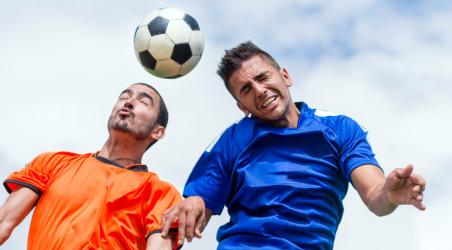Head injuries in soccer have garnered significant attention in recent years, with leagues taking steps to protect players and minimize the risk of long-term damage.
Chronic traumatic encephalopathy (CTE), a degenerative brain disease associated with repeated head trauma, has become a growing concern among athletes. Notable cases, such as Taylor Twellman’s experience in the New England Revolution, have highlighted the need for proactive measures in safeguarding players’ well-being.
Additionally, instances like English soccer star Jimmy Fryatt’s deterioration due to his exceptional heading ability have reinforced the importance of addressing head injuries in the sport. While leagues have organized events to discuss head injuries, there are concerns that these efforts might not go far enough in genuinely confronting the issue.
According to the Concussion Legacy Foundation, four former professional soccer players, including Fryatt, have recently been diagnosed with CTE. Alongside Fryatt, Jimmy Conway, Jimmy Gabriel, and Franny Pantuosco were found to have this degenerative brain disease.
The diagnoses have brought attention to the role of heading the ball as a potential cause of CTE, as Fryatt was known for his exceptional heading skills. The risk of CTE can extend beyond diagnosed concussions, with repeated sub-concussive blows also playing a role in its development.
The Head Injury Summit and its criticisms
Soccer officials gathered in Chicago for a Head Injury Summit, a conference co-hosted by U.S. Soccer and the top American professional leagues. However, CTE researchers and families of affected individuals express concerns that these events are more about appearance than a genuine commitment to addressing brain injuries.
Critics argue that the summit’s agenda, guest list, and even its name downplay the long-term effects of concussions and delay meaningful preventive measures. Dr. Ann McKee, director of the Boston University CTE Center, voices skepticism about the summits, seeing them as primarily PR stunts rather than platforms for substantive action.
Critics argue that the Head Injury Summit fails to address the issue effectively. The absence of researchers from the Boston University CTE Center, including renowned experts like Dr. McKee and Robert Cantu, raises concerns about the summit’s depth and commitment to scientific expertise.
By excluding critical voices with extensive knowledge of CTE, the summit may undermine efforts to implement meaningful changes in player safety. Furthermore, even the summit title, using “head injury” instead of “brain injury,” has been criticized as a tactic to downplay the severity of the issue.
The importance of inclusion and learning from personal experiences
One of the challenges in addressing CTE is the difficulty in diagnosing it during a person’s lifetime. CTE can only be definitively diagnosed posthumously, which limits the ability to identify cases and take preventive action.
Despite this challenge, researchers from the Boston University CTE Center have diagnosed over 100 football players with CTE and anticipate an increase in cases among soccer players as those who started playing the sport at a young age reach old age.
The involvement of families affected by CTE is crucial in recognizing the signs of brain injuries, as they often manifest years after the initial trauma and can profoundly affect behavior and cognition.
Taylor Twellman, a former professional soccer player for the New England Revolution, was at the pinnacle of his career in 2008 when multiple concussions abruptly ended his playing days at just 30 years old.
New England Revolution is currently battling for the top spot in the Eastern Conference. Massachusetts sportsbook promos are sure to help you increase your winnings if you are trying to put action on any Revolution games this year.
Since then, Twellman has transitioned into a soccer analyst role at ESPN and emerged as a prominent advocate for raising awareness about traumatic brain injuries in sports.
“During my professional career, I encountered three concussions. The final one, which occurred in 2008, ultimately forced me to retire and prompted my family and me to reflect on my history of head injuries. It is difficult to admit, but throughout my playing career, I estimate that I experienced six or seven diagnosed concussions. With the exception of one, all of these concussions resulted in temporary loss of consciousness.
Presently, I still encounter occasional symptoms. Headaches can arise depending on the time of year and my stress levels. One lasting impact is the severe limitation on my workouts; I am only able to engage in low-intensity activities such as walking. Even during exercise, my heart rate needs constant monitoring,” Twellman mentioned during an interview.
 Newspatrolling.com News cum Content Syndication Portal Online
Newspatrolling.com News cum Content Syndication Portal Online








